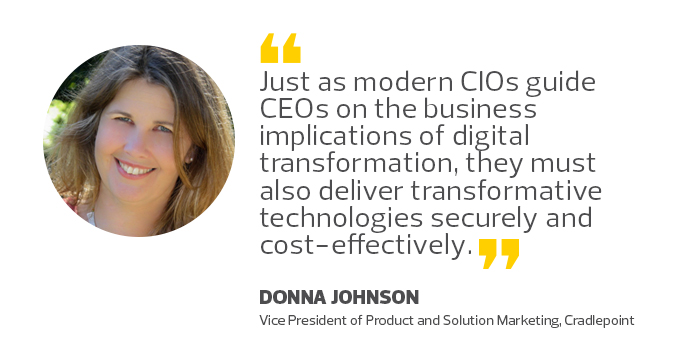As Networks Evolve, the Role of the CIO Must Change
Today’s CIO is not just expected to understand and integrate technology, but to anticipate how tech can be harnessed to drive business growth and transformation, product evolution, customer satisfaction and employee productivity. CIOs are in a position to drive change across their organizations to help them compete and grow.
Gartner’s annual CIO Agenda Report — the world’s largest CIO survey — emphasizes this point, showing that growth and the supporting digital transformation it requires are at the forefront of the modern CIO’s mind.
The report represents the views of more than 3,000 CIOs across almost 100 countries, covering nearly $13 trillion in revenue and $277 billion in IT spending. It is clear from the report that the evolving technology landscape is changing the very nature of the CIO’s job: from delivery executive to business executive.
SIGN UP: Get more news from the BizTech newsletter in your inbox every two weeks!
Why Network Evolution Is Critical to Business Transformation
Harnessing new technology for transformation and growth today requires an in-depth understanding of the network that ties the organization together, connects the organization to its customers and underpins the extended ecosystem and supply chain.
With an increasingly mobile workforce, expanded use of the Internet of Things (IoT) and enterprise traffic shifting from the private intranet to the public cloud, the network now extends far beyond the four walls of the office, reaching all parts of the distributed organization.
This means the network is where CIOs can find opportunities to drive change and transform how products are delivered. Here, they can expand data collection to create the analytics that are crucial to digital transformation and change the nature of work for their employees.
On the one hand, modern CIOs are acting as guides to CEOs on the business implications of digital transformation and how it can improve operational efficiencies, help capitalize on new opportunities and enable faster responses to changing market conditions and competitive pressures.
They are keenly aware of the level of IT transformation needed — thinking about how they can use Gigabit LTE, 5G wireless networks, IoT, mobile and cloud — to drive differentiation and value in the products they deliver.

On the other hand, they also have to deliver these technologies cost-effectively and securely. They’re responsible for hiring employees with the right skill sets and choosing the right vendors to partner with.
CIOs Must Redefine Their Corporate Networks
IDC claims that nearly 75 percent of the workforce will be afforded a mobile work style by 2020, while Gartner points out that IoT will make up the largest constituency of endpoints in the coming years, predicting that 7.5 billion connected devices will be deployed within enterprises over the same time frame.
The first question for all CIOs is whether their WAN is capable of supporting this transformation. But the question they should be asking is: Am I taking advantage of the rapid change occurring in networking technology to drive growth?
Cradlepoint’s recent “State of the Network” report highlights a lack of WAN readiness. According to the report, 77 percent of IT decision-makers surveyed, from businesses of all sizes, cited their top concerns as WAN bandwidth limitations, reliability and cost. Organizations in all industries need to transform their WANs to take advantage of the new technologies, which require more bandwidth, heightened mobility, greater agility and better security.
The traditional networking approach is no longer sufficient. What’s becoming increasingly clear is that transforming WAN is central to wider business transformation. The challenge for CIOs is to work out how they can deliver and take advantage of new technologies. However, this must start with a proactive approach to WAN transformation.
A great example is the wireless WAN, which we are now seeing take off in a big way. It presents a stark comparison to the expensive and restrictive WANs of the past. The wireless WAN, particularly when powered by Gigabit LTE and 5G, delivers more bandwidth and performance than many wired networks, while also providing extreme flexibility at the edge.
What Will the CIO of Tomorrow Look Like?
Technology will develop, and it will be down to the CIO to decide how to harness it. Methods used in the past will not be sufficient to keep up with and address the challenges of the future.
It’s clear from Gartner’s CIO Agenda Report that success in this next chapter will not be based on what CIOs build, but what they integrate and whether they use technology change to drive business change. The job description seems to be moving away from a manufacturer or architect role to that of a buyer.
The CIO of tomorrow will become the selector, an expert orchestrator of services conducting a symphony of next-generation software and services. As an example, CIOs will move away from a “build your own” approach (trying to build and manage a digital network themselves) toward a Network as a Service approach. CIOs have seen a proven track record of success with Software as a Service; the enterprise WAN is the natural next step.
The CIO is facing a wave of new challenges, from artificial intelligence to evolving security threats. Identifying and harnessing the skills required to meet these is a fundamental mission for modern CIOs. Having the judgment to invest in the right emerging technologies — and the wisdom to retire others — will be profoundly important over the coming years.








